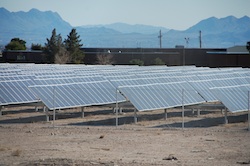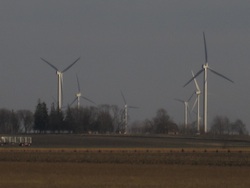According to a new report by Synapse Energy Economics prepared on behalf of the Civil Society Institute (CSI), if the U.S. ceases to burn coal, shuts down a quarter of existing nuclear reactors the trims its use of natural gas by 2050, the resulting increased reliance on wind, solar and other renewables will not result in a less  reliable electricity grid. The new study finds that, in the envisioned 2050 with a heavy reliance on renewables, regional electricity generation supply could meet or exceed demand in 99.4 percent of hours, with load being met without imports from other regions and without turning to reserve storage. In addition, surplus power would be available to export in 8.6 percent of all hours, providing an ample safety net where needed from one region of the U.S. to the next.
reliable electricity grid. The new study finds that, in the envisioned 2050 with a heavy reliance on renewables, regional electricity generation supply could meet or exceed demand in 99.4 percent of hours, with load being met without imports from other regions and without turning to reserve storage. In addition, surplus power would be available to export in 8.6 percent of all hours, providing an ample safety net where needed from one region of the U.S. to the next.
“This study shows that the U.S. electricity grid could integrate and balance many times the current level of renewables with no additional reliability issues,” said Grant Smith, senior energy analyst, Civil Society Institute. “Recent improvements in both renewable technologies themselves and in the technologies that are used to control and balance the grid have been proceeding at a rapid pace, and the incentives and rewards for success in this area continue to drive substantial progress.”
“In contrast, the alternative—continuing to rely on increasing combustion of fossil fuels to generate electricity, and producing ever-increasing levels of greenhouse gases—is far less feasible, and presents much more daunting technical, economic, and social challenges to human and environmental welfare. In comparison, the challenge of integrating increasing levels of solar and wind power on the U.S. power grids requires only incremental improvements in technology and operational practices, added Smith.”
Listen to Grant Smith’s presentation here: Adding Renewables Doesn't Create Reliability Issues
Report co-author Dr. Thomas Vitolo, analyst, Synapse Energy Economics, explained, “Put simply, the message today is this: It is a myth to say that the United States cannot rely on renewables for the bulk of its electricity generation. This study finds that the projected mixes, based entirely on existing technology and operational practices, are capable of balancing projected load in 2030 and 2050 for each region—in nearly every hour of every season of the year.”
Listen to Tommy Vitolo’s presentation here: The Lights Will Stay On with Renewables
In 2011, Synapse prepared a study for the Civil Society Institute that introduced a “Transition Scenario” in which the United States retires all of its coal plants and a quarter of its nuclear plants by 2050, moving instead toward a power system based on energy efficiency and renewable energy. The Synapse study for CSI showed  that this Transition Scenario, in addition to achieving significant reductions in emissions of carbon dioxide (CO2) and other pollutants, ultimately costs society less than a “business as usual” status quo strategy — even without considering the cost of carbon. The 2011 study also projected that, over 40 years, the Transition Scenario would result in savings of $83 billion (present value) compared to the status quo strategy.
that this Transition Scenario, in addition to achieving significant reductions in emissions of carbon dioxide (CO2) and other pollutants, ultimately costs society less than a “business as usual” status quo strategy — even without considering the cost of carbon. The 2011 study also projected that, over 40 years, the Transition Scenario would result in savings of $83 billion (present value) compared to the status quo strategy.
To achieve these lower-cost and low-emissions results, the Transition Scenario included large amounts of renewable energy resources with “variable output,” such as wind and solar. While the need for variable-output resources is well defined, questions have been raised about the impact of large-scale wind and solar integration on electric system reliability. To address this, Synapse paid careful attention to the amount of wind and solar in each region when designing the Transition Scenario for the 2011 report, taking steps to ensure that the projected regional resource mixes could respond to all load conditions.
The new 2013 study for the Civil Society Institute takes the analysis one big step farther, in order to explore the extent to which the Transition Scenario’s resource mixes for 2030 and 2050 are capable of meeting projected load for each of the 10 studied regions — not just during peak demand conditions, but in every hour of every season of the year as consumers require.

